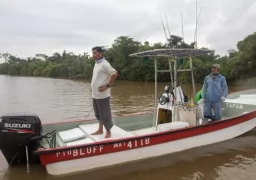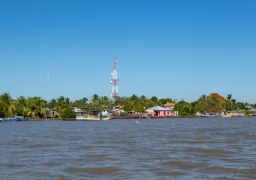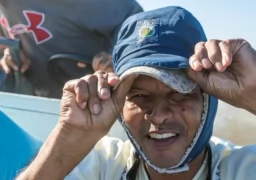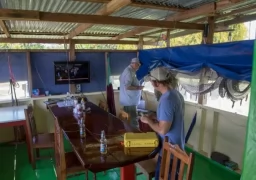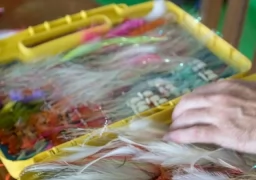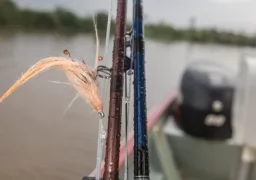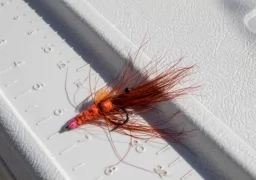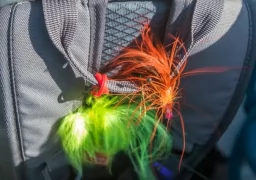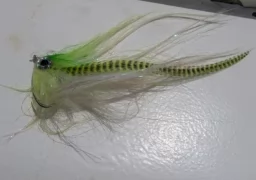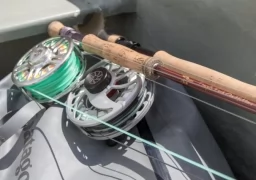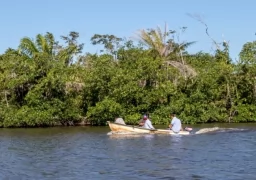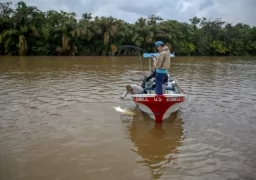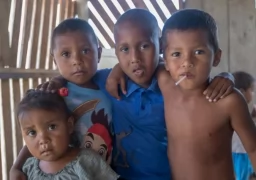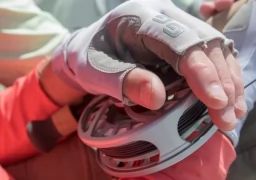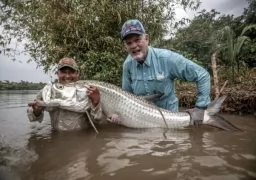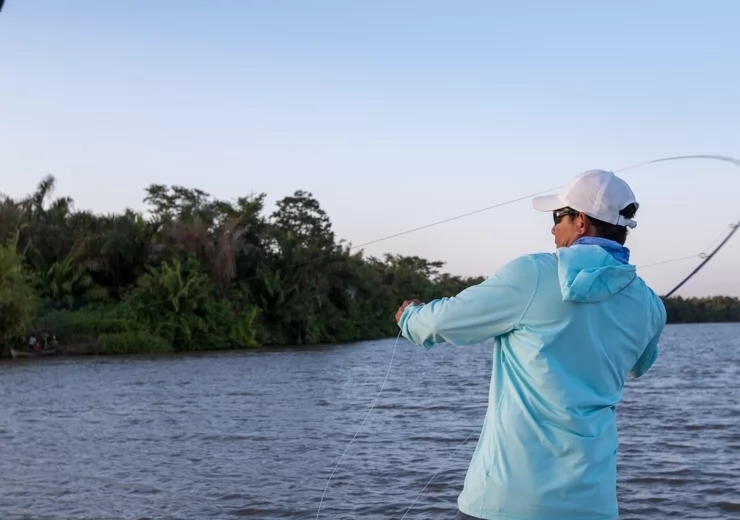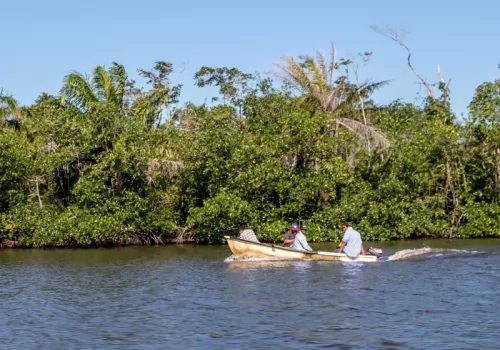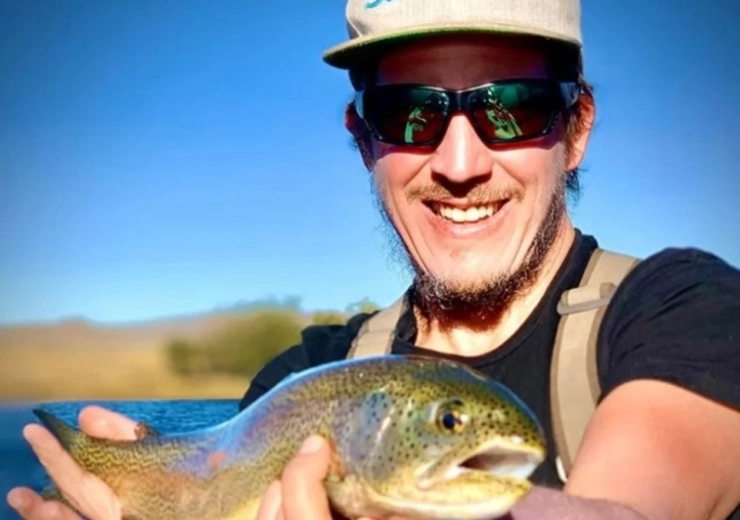NEWS & REPORTS
Giant Tarpon Fishing - Nicaragua Part II
Welcome to Managua, the capital city of Nicaragua. Why would I travel to the middle of the jungle, stay in a rustic and simple lodge, and sometimes blindcast for hours to fish tarpon? The answer is simple: it's because these jungle tarpon are giant. That's right, they are huge fish and this area is a worldwide destination for fly fishing monster tarpon. This is a once-in-a-lifetime experience, and I myself will be the witness of it.
The first surprise about Managua was that I had for breakfast two eggs, rice, beans, fried bananas, and the most interesting thing was that, for the first time in my life - and I’m 44 now - I ate fried cheese.
“Queso Frito,” as it is called in Spanish, is a typical dish in Nicaragua. It is usually served at breakfast and it consists of a white, salty cheese with a high melting point called frying cheese or white cheese. It’s delicious, now I should definitely learn its recipe so that I can cook it at home!
In Managua, the food is actually not sophisticated, and neither is its airport. Right now, I’m here, drinking Victoria and Toña beer from Nicaragua. The good thing I can say about it is that the beer is very cold! And also, I should recommend that if you come to Nicaragua, you should drink Ron. Flor de Caña is the typical Ron is and it costs only 5 bucks.
The weather is hot, but there is a nice breeze. The airport is pretty small, I’d dare say it’s not bigger than a bar in Jesus Maria, the town where I live. There is not a bar in this airport to wait here so I’m gonna listen to some Spotify music and wait for my luggage. In there, I am carrying extremely important things: my Sage rods and the hooks, which I really need for tomorrow. So, I’m gonna be patient and wait – there’s no other way out.
If you ever come here, you should first arrive at Bluefields the day before your trip begins. You will stay at the Casa Rosa lodge and leave for the jungle early the next morning.
All right… it’s been 48 hours since I’m in Tapam Lodge. My luggage didn’t show up, so I ended up with Fernando having drinks at a local bar some meters away from the airport.
We had some beers and Ron, and after an hour my luggage arrived. Finally, we took a taxi and we arrived at Casa Rosa, a very nice and cozy house opposite to the river. We spent the night there waiting for the boat, our ride for the next day to the jungle lodge, which is a three-hour ride from where we are now.
The lodge is colorful, pretty nice and comfortable. The food was good, but the guest service could be better. With a little attention, it could improve. The rooms are nice, the showers OK. You have to understand that this is just a place to spend the night on your way in and out because logistics to get to Tapam are not that simple. There are three flights coming from Managua to Bluefields and one of those you have to take to go there. Normally, what happens is that these airplanes can carry up to twelve people and therefore, not much luggage, so normally a bigger plane which goes to Corn Island takes the luggage and leaves it on its way back. That’s why my luggage never showed up.
We met Mark, one of our guides, and Rosa, that’s why the place is called Casa Rosa, which translates to Pink House. We also met Jimmy Martinez, the other guy who would be our guide. Then, we started our trip to the lodge. While traveling, we crossed lagoons of different size – some of them similar to lakes and others very small lagoons – channels, and rivers. They are not very deep, 2 or 3 feet of depth, and then it can drop to 14 or 15 feet, and sometimes up to 40, but not more than that.
We almost crash with a speeding boat! Thank God, nothing happened, though it could have been really bad. So, when you come to these places like Nicaragua, there are some unexpected things like complications with flights, luggage, etc. I dare describe this place in my friend’s words, “This is not a place for tourists but for travelers.”
We arrived at the Tapam Lodge before noon and Randy, the guy who runs this place, surprised us with some drinks and a very nice lunch. We were very excited and wanted to go fishing ASAP. The lodge is situated near Kara, a small little town inhabited by local people who live off the fishing and the hunting.
It’s a very very small place. Aboriginal people live in this area and they have community rights over that piece of land, which actually belongs to them. There are different aboriginal communities which speak several languages. They make use of the land and the rivers. In this case, the outfitter needs to have a sort of “special” permission to enter the area.
Mark, who is an expert fisherman, was going to be our guide, as I said. He set up all my reels and my lines, put the leaders, etc. And then, we met Jimmy Martinez, who is in his fifties and he has been fishing throughout his life. He’s very talented in the water. We also had the pleasure to meet Oscar, Marco’s brother. We are going to be fishing together these days. These guys suggested getting two rods ready, one with an intermediate and another with a very heavy sinking line to go deeper.
As regards the fishing here, it is possible to fish long days; from early morning until it gets dark. Normally, fishermen take a break in the middle of the day and go back to the lodge for lunch and a short rest. Most of the known fishing spots are within a 30 to 40 minutes boat ride from the lodge, and we fish in rivers, lagoons, and deltas. Most spots are from 10-30 feet deep but when the tarpon are actively hunting they will take flies just below the surface. As most of the fishing is blind casting or casting to rolling fish two anglers can fish at the same time.
As for the species, though our fishing is focused on tarpon, jack crevalle, snook, and smaller catfish are possible by catches when fishing for tarpon.
Suggestions for your packing list:
- Fishing equipment #11 or #12 rod and reels with good drags and 300 meters of backing (45 lbs) – and at least one spare rod and reel. Intermediate tarpon fly line with high breaking strength (Scientific Anglers Sonar Saltwater Intermediate is a great line to fish). Sinking tarpon fly line (Rio Leviathan 26ft Sink Tip in 400 or 500 grains). Chock tippet, flourocarbon. We recommend Seaguar Big Game 125 lbs or Premier 130 lbs (both 1,05 mm).
- Big baitfish flies: When the tarpon are in a frenzy, feeding on mullets, you could throw a 40 cm (16 inches) fly and it would still match the hatch. However, flies of 15-18 cm (6-7 inches) are not only easier to cast – they hook much better, too. For size, 18 cm (7 inches) are about the biggest we fish. With flies bigger than that you risk having tarpon missing the hook, only biting the tail end of the fly.
- Medium sized baitfish flies: We sometimes find good numbers of tarpon in clear water rivers. They are often laid up a few feet below the surface and sooner or later they will start feeding, though not always very aggressively. On such occasions smaller baitfish flies of 11-13 cm (5 inches) with lots of movement works better than the bigger mullet imitations.
- Colors for baitfish flies: A good starting point is a fly a light in color like, tan or white, preferably with lots of flash. You can add a bit of chartreuse, brown or blue. The baitfish flies we fish for tarpon will also tempt snook and jacks, if the opportunity arises.
- Shrimp flies: The shrimps in these waters are big; easily 12-15 cm (5-6 inches) from head to tail so don’t be afraid to fish big shrimp flies. The pink is our favorite in clear water and black/purple can work well in colored water. We have also fished a yellow/grey shrimp with success. Surely, other colors could work too.
- Hooks: In these waters there is a very real chance of hooking a really big tarpon. Super strong hooks are a must! Our favorite is the Varivas 2600V made from heavy carbon wire. These hooks have yet to let us down by breaking or opening – and they hook better than any other hook we have tried. We use them in 4/0 for baitfish flies and in 4/0 or 3/0 for shrimp flies. Hook sizes wary from one model to another. For Owner AKI 5/0 and 4/0 would be the right choices.
Each of us set two rods. I only had one twelve and another ten. I had the very heavy line on my Sage rod. On the leaders, we had a 120-pound fluorocarbon, 6 to 7 feet of leader, and then we got very colorful flies with the most important thing: the hooks! We used very high-quality hooks so that they could not break. We got on the boat ride for like half an hour and we checked an area. We did some blind casting.
One of the things you need to know if you ever come to the Tapam area is that you are not going to be able to do sightseeing fishing.
At the beginning, we did a couple of casts for 45 minutes and then, Mark, our guide, decided to change the location, so we got on another boat ride for like 20 minutes to a different place to start the blind casting again trying to get some fish.
On our very first day, nothing happened. We were 5 fishermen in 3 different boats which changed spot several times. And nothing happened. Nobody caught a single fish. Only Mark got a bite, the fish jumped and then, he lost it. They said it could be between a fish weighing 100 or 120 pounds, but the true story is that nobody can say exactly how big the fish was.
On the backing of each line, we were having a 50-pound fly land backing, about 350 to 450 yards backing, we got the two tones, GSP backing, high quality, super smooth break, 100% reliable. The backing is very important because 50% of the time, the fish are going to take the line when you’re fishing for big tarpon. On my other reel, I tried Cortland fly line backing, it was a 300-yard backing that I had on the intermediate line.
THE BOAT ISSUE
I think the problem of the first day was that the engine of the boat had some sort of problem and it was not easy to get it started. You know, having problems with the engine is something that can happen, shit can always happen, but you never expect it to do so. In these cases, you change your fishing attitude, you change your mood... Mark had a great attitude towards the fishing, and that is very important when shit happens because you need to be optimistic and try to solve the problem.
We understand that these things can happen, so we should always try to put a good face when there’s bad weather. Unexpected things in life happen... and this led me to think for a moment about that...
By the way... my idea of happiness includes trips to exciting and unexpected destinations, great music such as Eagles, Dire Strait, Rolling Stones and also getting lost somewhere with a fishing rod. Happiness for me is being in touch with nature, water, the land, the remote areas, and the unexpected. If life doesn’t surprise us, it becomes as boring as routine; and routine kills the joy of living. So, do not let routine ruin your life.
It is all about being with yourself and listening to yourself, fishing is just the excuse to get closer to paradise before getting a ticket to paradise. Fishing is poetry and we should read poetry more often. Be ready for your next unexpected trip, who knows what would happen tomorrow! My advice: enjoy life and go fishing.
Hey, guys! This is not the end...
In the last two days of fishing, we could catch several monster tarpon!
I bet you do not want to miss the third part of this AMAZING fly fishing trip!
Stay tuned for more!
Pablo Aguiló
Pointer Outfitters

